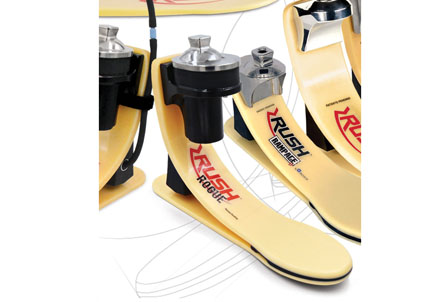Prosthetic Feet
A good prosthetic leg must be strong because it requires a lot of force and torque when the user walks and runs. Also, It should be that the feet comes in different sizes and is prescribed as per the other side matching feet length. The challenge is to be light, strong and small, yet functional and durable. Early models of prosthetic legs were often made of solid wood. The same type of SACH (Solid-Ankle-Cushioned Heel) is still used for this support function, which is especially useful for less active people. A SACH leg usually has a rigid internal structure (wood or plastic) that is enclosed in a compressible foam shell.
Today's advanced legs, which offer more functionality, are found in a cosmetic shell. Most people will never see their prosthetic leg without its outer shell. A cosmetic cover that extends around the prosthetic leg and holds it in place, the purpose of which is to give the prosthesis the appearance of an anatomical leg and fill the space of the shoe.

Prosthetic feet are designed according to needs that suit the user's lifestyle and activity level.
Factors to consider may include:
Materials: Prosthetic feet materials vary by activity level/movement category. Wood, plastic and foam are commonly found in legs designed for people with limited mobility who need stability. Carbon fiber legs meet the functional needs of shock absorption and energy efficiency, and are also lightweight.
Comfort: The prosthetic leg should be good and meet all performance goals. Comfort allows the user to be more active, and the work of the prosthetic leg directly affects comfort.
Function: The foot prosthesis must act as a shock absorber when the heel hits the ground, adapt to uneven terrain and ensure smooth rolling. from heel to toe and provides a rigid lever to push forward when they stop their gait ("toe off").
Multi axial Motion: Some prosthesis are designed to mimic the ankle, allowing the foot to move in multiple planes. Walking comfortably and confidently on uneven ground requires multi-axial movement as your foot adapts to what it encounters.
Energy storage: To store energy, the carbon fiber foot acts as a spring, compressing your weight and propelling you forward. As the foot bend forward, returning energy to your stride as the spring releases.
Body weight: Prosthesis are designed for a specific weight. To ensure that the prosthetic leg works well for the user, choose the appropriate one for their weight class.
Transition: When the user stands, the prosthesis fills the space between the residual limb and the floor. It is designed to add the length needed to flatten or balance the other leg. Most prosthetic legs are between 2 and 7 inches long. As a result, losing a limb near the ankle can limit some low-profile prosthetic legs.
Recommended covers and colors: Covers can be ordered in colors to match the skin tone, in different sizes and often divided. Flip flops Inexpensive shells may lack details such as toes and may be attached to a prosthetic leg. Above, the toes and skin colors are more realistic. Activity level 3 or 4 should look for a durable leg that can be completely replaced after wear due to sharp edge, impact level and use.
Cost: Prosthetic legs tend to be more expensive with activity level, as more functionality means more structure. and more expensive materials. Before making a final choice, make sure that the prosthetic leg you choose allows the end user to increase or maintain activity, longer working hours and an active and dynamic life.































